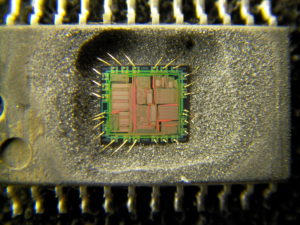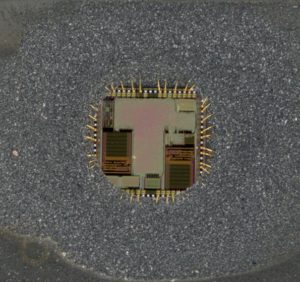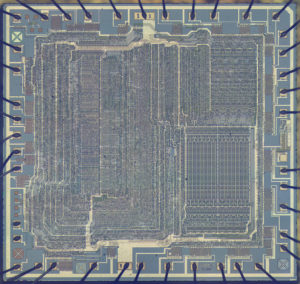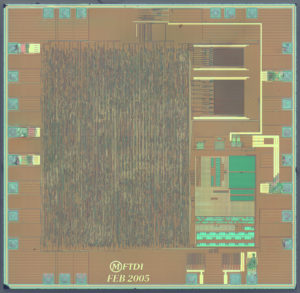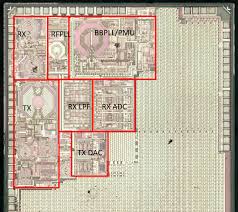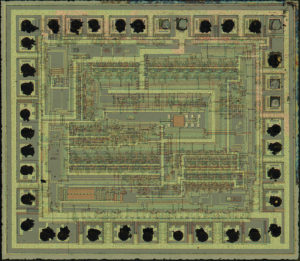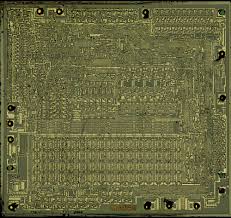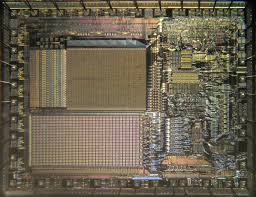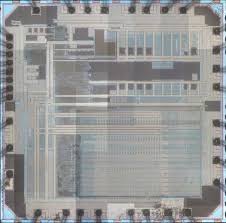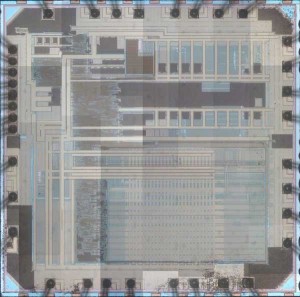Archive for the ‘Recover MCU’ Category
 Attack Microcontroller MC68HC705P6ACDW Binary
Attack Microcontroller MC68HC705P6ACDW Binary
We can Attack Microcontroller MC68HC705P6ACDW Binary, please view Microcontroller MC68HC705P6ACDW feature for your reference:
Features of the MC68HC705P6A include:
· Low cost
· M68HC05 core
· 28-pin SOIC, PDIP, or windowed DIP package
· 4672 bytes of user EPROM (including 48 bytes of page zero EPROM and 16 bytes of user vectors)
· 239 bytes of bootloader ROM
· 176 bytes of on-chip RAM
· 4-channel 8-bit A/D converter
· SIOP serial communications port
· 16-bit timer with output compare and input capture
· 20 bidirectional I/O lines and 1 input-only line
· PC0 and PC1 high-current outputs
· Single-chip, bootloader, and test modes
· Power-saving stop, halt, and wait modes
· Static EPROM mask option register (MOR) selectable options:
– COP watchdog timer enable or disable
– Edge-sensitive or edge- and level-sensitive external interrupt
– SIOP most significant bit (MSB) or least significant bit (LSB) first
– SIOP clock rates: OSC divided by 8, 16, 32, or 64
– Stop instruction mode, STOP or HALT
– EPROM security external lockout
– Programmable keyscan (pullups/interrupts) on PA0–PA7
Circuit Engineering Company Limited continues to be recognized as the Southern China Leader in Services for IC Break, MCU crack, Chip Recover, Microcontroller Copy service. With the advancement of today’s modern circuit board technology, it is more important than ever to have specialists available to help you at a moment’s notice. Our engineering and commercial teams collectively have a vast amount of electronic experience covering field include Consumer Electronics, Industrial Automation Electronics, Wireless Communication Electronics., etc. For more information please contact us through email.
 Attack MCU TMX320F28027PTA Archive
Attack MCU TMX320F28027PTA Archive
We can Attack MCU TMX320F28027PTA Archive, please view MCU TMX320F28027PTA features for your reference:
Highlights
– High-Efficiency 32-Bit CPU ( TMS320C28x™)
– 60-MHz, 50-MHz, and 40-MHz Devices
– Single 3.3-V Supply
– Integrated Power-on and Brown-out Resets
– Two Internal Zero-pin Oscillators
– Up to 22 Multiplexed GPIO Pins
– Three 32-Bit CPU Timers
– On-Chip Flash, SARAM, OTP Memory
– Code-security Module
– Serial Port Peripherals (SCI/SPI/I2C)
– Enhanced Control Peripherals
· Low Device and System Cost:
– Single 3.3-V Supply
– No Power Sequencing Requirement
– Integrated Power-on and Brown-out Resets
– Small Packaging, as Low as 38-Pin Available
– Low Power
– No Analog Support Pins
· Clocking:
– Two Internal Zero-pin Oscillators
– On-Chip Crystal Oscillator/External Clock Input
– Dynamic PLL Ratio Changes Supported
Enhanced Pulse Width Modulator (ePWM) And High-Resolution PWM (HRPWM)
– Watchdog Timer Module
– Missing Clock Detection Circuitry
· Enhanced Capture (eCAP)
· Analog-to-Digital Converter (ADC)
· On-Chip Temperature Sensor
· Comparator
– 38-Pin and 48-Pin Packages
· High-Efficiency 32-Bit CPU ( TMS320C28x™)
– 60 MHz (16.67-ns Cycle Time)
– 50 MHz (20-ns Cycle Time)
– 40 MHz (25-ns Cycle Time)
– 16 x 16 and 32 x 32 MAC Operations
– 16 x 16 Dual MAC
– Harvard Bus Architecture
– Atomic Operations
– Fast Interrupt Response and Processing
– Unified Memory Programming Model
– Code-Efficient (in C/C++ and Assembly)
· Endianness: Little Endian
· Up to 22 Individually Programmable, Multiplexed GPIO Pins With Input Filtering
· Peripheral Interrupt Expansion (PIE) Block That Supports All Peripheral Interrupts to Unlock Microcontroller
· Three 32-Bit CPU Timers
· Independent 16-Bit Timer in Each ePWM
Module
· On-Chip Memory
– Flash, SARAM, OTP, Boot ROM Available
· 128-Bit Security Key/Lock
– Protects Secure Memory Blocks
– Prevents Firmware Reverse Engineering
· Serial Port Peripherals
– One SCI (UART) Module
– One SPI Module
– One Inter-Integrated-Circuit (I2C) Bus
· Advanced Emulation Features
– Analysis and Breakpoint Functions
– Real-Time Debug via Hardware
· 2802x, 2802xx Packages
– 38-Pin DA Thin Shrink Small-Outline Package (TSSOP)
– 48-Pin PT Low-Profile Quad Flatpack (LQFP)
 Attack IC ADUC831BSZ Firmware
Attack IC ADUC831BSZ Firmware
we can Attack IC ADUC831BSZ Firmware, please find below IC ADUC831BSZ features for your reference:
ANALOG I/O
FUNCTIONAL BLOCK DIAGRAM
8-Channel, 247 kSPS 12-Bit ADC
DC Performance: 1 LSB INL
ADuC831
12-BIT
DAC BUF DAC
AC Performance: 71 dB SNR
DMA Controller for High Speed ADC-to-RAM Capture
2 12-Bit (Monotonic) Voltage Output DACs
Dual Output PWM/ – DACs
On-Chip Temperature Sensor Function 3 C
ADC0
ADC1
MUX
T/H 12-BIT ADC 12-BIT DAC 16-BIT
– DAC BUF DAC
On-Chip Voltage Reference
ADC5
Memory
62 kBytes On-Chip Flash/EE Program Memory
4 kBytes On-Chip Flash/EE Data Memory
ADC6
ADC7
TEMP
HARDWARE
CALIBRATON
16-BIT
– DAC
16-BIT
PWM
MUX
PWM0
PWM1
Flash/EE, 100 Yr Retention, 100 kCycles Endurance
2304 Bytes On-Chip Data RAM
8051 Based Core
8051 Compatible Instruction Set (16 MHz Max) to Clone IC
12 Interrupt Sources, 2 Priority Levels
Dual Data Pointer
SENSOR
16-BIT
PWM 8051-BASED MCU WITH ADDITIONAL
PERIPHERALS
62 kBYTES FLASH/EE PROGRAM MEMORY
4 kBYTES FLASH/EE DATA MEMORY
2304 BYTES USER RAM
Extended 11-Bit Stack Pointer
3
16 BIT TIMERS
POWER SUPPLY MON
On-Chip Peripherals
Time Interval Counter (TIC)
UART, I2C®, and SPI® Serial I/O
Watchdog Timer (WDT), Power Supply Monitor (PSM)
INTERNAL
BAND GAP
VREF
VREF
OSC
XTAL1
XTAL2
1
REAL TIME CLOCK
PARALLEL
PORTS
WATCHDOG TIMER
UART, I2 C, AND SPI
SERIAL I/O
Power
Specified for 3 V and 5 V Operation
Normal, Idle, and Power-Down Modes
Power-Down: 20 A @ 3 V
APPLICATIONS
Optical Networking—Laser Power Control
Base Station Systems
Precision Instrumentation, Smart Sensors
Transient Capture Systems
DAS and Communications Systems
Pin compatible upgrade to existing ADuC812 systems
that require additional code or data memory. Runs
from 1 MHz–16 MHz to external crystal.
The ADuC832 is also available. Functionally is the same
as the ADuC831, except the ADuC832 runs from a 32 kHz
external crystal with on-chip PLL
 Attack Chip PIC18F66K90 software
Attack Chip PIC18F66K90 software
Attack Chip PIC18F66K90 starts from decapsulate the microcontroller silicon package and locate the security fuse bit which has been viewed an most commonly way to crack MCU, then extract the software out from the memory;
Low-Power Features:
· Power-Managed modes:
– Run: CPU on, peripherals on
– Idle: CPU off, peripherals on
– Sleep: CPU off, peripherals off
· Two-Speed Oscillator Start-up
· Fail-Safe Clock Monitor
· Power-Saving Peripheral Module Disable (PMD)
· Ultra Low-Power Wake-up
· Fast Wake-up, 2 ms Typical
· Low-Power WDT, 300 nA Typical
· Ultra Low 50 nA Input Leakage
· Run mode Currents Down to very low 5.5 mA, Typical
· Idle mode Currents Down to very low 2.2 mA, Typical
· Sleep mode Current Down to very low 20 nA, Typical
· RTCC Current Down to very low 700 nA, Typical
· LCD Current Down to very low 300 nA, Typical
LCD Driver and Keypad Features:
· Direct LCD Panel Drive Capability:
– Can drive LCD panel while in Sleep mode
· Up to 48 Segments and 192 Pixels, Software-Selectable
· Programmable LCD Timing module:
– Multiple LCD timing sources available
– Up to four commons: static, 1/2, 1/3 or 1/4 multiplex
– Bias configuration: Static, 1/2 or 1/3
· Low-Power Resistor Bias Network for LCD
Peripheral Highlights:
· Ten or eight CCP/ECCP modules:
– Seven Capture/Compare/PWM (CCP) modules
– Three Enhanced Capture/Compare/PWM (ECCP) modules
· Eleven 8/16-Bit Timer/Counter modules:
– Timer0 – 8/16-bit timer/counter with 8-bit programmable prescaler
– Timer1,3,5,7 – 16-bit timer/counter
– Timer2,4,6,8,10,12 – 8-bit timer/counter
· Three Analog Comparators
· Configurable Reference Clock Output
· Hardware Real-Time Clock and Calendar (RTCC) module with Clock, Calendar and Alarm Functions
– Time-out from 0.5s to 1 year
· Charge Time Measurement Unit (CTMU)
– Capacitance measurement for mTouch™ Sensing
– Time measurement with 1 ns typical resolution
· High-Current Sink/Source 25 mA/25 mA (PORTB and PORTC)
· Up to Four External Interrupts
· Two Master Synchronous Serial Port (MSSP) modules:
– 3/4-wire SPI (supports all four SPI modes)
– I2C™ Master and Slave mode
Special Microcontroller Features:
· Priority Levels for Interrupts
Operating Voltage Range: 1.8V to 5.5V
On-Chip 3.3V Regulator
Operating Speed up to 64 MHz
Up to 128 Kbytes On-Chip Flash Program Memory Data EEPROM of 1,024 Bytes
4K x 8 General Purpose Registers (SRAM)
10,000 Erase/Write Cycle Flash Program
Memory, Typical 1,000,000 Erase/write Cycle Data EEPROM
Memory, Typical Flash Retention 40 Years, Minimum
Three Internal Oscillators: LF-INTRC (31 kHz),
MF-INTOSC (500 kHz) and HF-INTOSC (16 MHz)
Self-Programmable under Software Control
· 8 x 8 Single-Cycle Hardware Multiplier
· Extended Watchdog Timer (WDT):
– Programmable period from 4 ms to 4,194s (about 70 minutes)
· In-Circuit Serial Programming™ (ICSP™) via
Two Pins
· In-Circuit Debug via Two Pins
· Programmable:
– BOR
– LVD
· Two Enhanced Addressable USART modules:
– LIN/J2602 support
– Auto-Baud Detect (ABD)
· 12-Bit A/D Converter with up to 24 Channels:
– Auto-acquisition and Sleep operation
– Differential Input mode of operation
 Attack Microcontroller PIC18F66K90 Heximal
Attack Microcontroller PIC18F66K90 Heximal
Attack Microcontroller PIC18F66K90 locked memory cell include flash and eeprom, disable the security fuse bits and get access to the databus of MCU then readout the Heximal and clone content to new IC;
Low-Power Features:
· Power-Managed modes:
– Run: CPU on, peripherals on
– Idle: CPU off, peripherals on
– Sleep: CPU off, peripherals off
· Two-Speed Oscillator Start-up
· Fail-Safe Clock Monitor
· Power-Saving Peripheral Module Disable (PMD)
· Ultra Low-Power Wake-up
· Fast Wake-up, 2 ms Typical
· Low-Power WDT, 300 nA Typical
· Ultra Low 50 nA Input Leakage
· Run mode Currents Down to very low 5.5 mA, Typical
· Idle mode Currents Down to very low 2.2 mA, Typical
· Sleep mode Current Down to very low 20 nA, Typical
· RTCC Current Down to very low 700 nA, Typical
· LCD Current Down to very low 300 nA, Typical LCD Driver and Keypad Features:
· Direct LCD Panel Drive Capability:
– Can drive LCD panel while in Sleep mode
· Up to 48 Segments and 192 Pixels, Software-Selectable
· Programmable LCD Timing module:
– Multiple LCD timing sources available
– Up to four commons: static, 1/2, 1/3 or 1/4 multiplex
– Bias configuration: Static, 1/2 or 1/3
· Low-Power Resistor Bias Network for LCD Peripheral Highlights:
· Ten or eight CCP/ECCP modules:
– Seven Capture/Compare/PWM (CCP) modules
– Three Enhanced Capture/Compare/PWM (ECCP) modules
· Eleven 8/16-Bit Timer/Counter modules:
– Timer0 – 8/16-bit timer/counter with 8-bit programmable prescaler
– Timer1,3,5,7 – 16-bit timer/counter
– Timer2,4,6,8,10,12 – 8-bit timer/counter
· Three Analog Comparators
· Configurable Reference Clock Output
· Hardware Real-Time Clock and Calendar (RTCC) module with Clock, Calendar and Alarm Functions
– Time-out from 0.5s to 1 year
· Charge Time Measurement Unit (CTMU):
– Capacitance measurement for mTouch™ Sensing
– Time measurement with 1 ns typical resolution
· High-Current Sink/Source 25 mA/25 mA (PORTB and PORTC)
· Up to Four External Interrupts
· Two Master Synchronous Serial Port (MSSP) modules:
– 3/4-wire SPI (supports all four SPI modes)
– I2C™ Master and Slave mode
Special Microcontroller Features:
· Priority Levels for Interrupts
Operating Voltage Range: 1.8V to 5.5V
On-Chip 3.3V Regulator
Operating Speed up to 64 MHz
Up to 128 Kbytes On-Chip Flash Program Memory Data EEPROM of 1,024 Bytes
4K x 8 General Purpose Registers (SRAM)
10,000 Erase/Write Cycle Flash Program
Memory, Typical 1,000,000 Erase/write Cycle Data EEPROM
Memory, Typical Flash Retention 40 Years, Minimum
Three Internal Oscillators: LF-INTRC (31 kHz),
MF-INTOSC (500 kHz) and HF-INTOSC (16 MHz)
Self-Programmable under Software Control
· 8 x 8 Single-Cycle Hardware Multiplier
· Extended Watchdog Timer (WDT):
– Programmable period from 4 ms to 4,194s (about 70 minutes)
· In-Circuit Serial Programming™ (ICSP™) via Two Pins
· In-Circuit Debug via Two Pins
· Programmable:
– BOR
– LVD
· Two Enhanced Addressable USART modules:
– LIN/J2602 support
– Auto-Baud Detect (ABD)
· 12-Bit A/D Converter with up to 24 Channels:
– Auto-acquisition and Sleep operation
– Differential Input mode of operation
 Attack MCU PIC16F887 Program
Attack MCU PIC16F887 Program
Attack MCU PIC16F887 tamper resistance system and readout the Program and data from its flash memory and eeprom memory, clone firmware to new IC which will provide the same functions as original Microcontroller PIC16F887;
Module: Analog-To-Digital Converter (ADC) Module
Selecting the VP6 reference as the analog input source (CHS<3:0> = 1111) for the ADC conversion after sampling another analog channel with input voltages approximately greater than 3.6V can temporarily disturb the HFINTOSC oscillator.
4. Module: MSSP (SPI Master Mode)
With MSSP in SPI Master mode, FOSC/64 or Timer2/2 clock rate and CKE = 0, a write collision may occur if SSPBUF is loaded immediately after the transfer is complete after Attack MCU. A delay may be required after the MSSP Interrupt Flag bit, SSPIF, is set or the Buffer Full bit, BF, is set and before writing SSPBUF. If the delay is insufficiently short, a write register and NOT during the start of an actual ADC conversion using the GO/DONE bit in the ADCON0 register.
This only occurs when selecting the VP6 reference ADC channel using the CHS<3:0> bits in the ADCON0 collision may occur as indicated by the WCOL bit being set.
Select an ADC channel with input voltages lower than 3.6V prior to selecting the VP6 reference voltage input. Any analog channel can be used, even if that channel is configured as a digital I/O (configured as an output) that is driving the output pin low when Attack MCU. An alternative is to configure the CVREF module to output a voltage less than 3.6V and then selecting that analog channel CHS<3:0> = 1110 as the analog input source.
Add a software delay of one SCK period after detecting the completed transfer and prior to updating the SSPBUF contents. Verify the WCOL bit is clear after writing SSPBUF. If the WCOL is set, clear the bit in software and rewrite the SSPBUF register.
Date Codes that pertain to this issue:
All engineering and production devices.
Affected Silicon Revisions
 Attack IC PIC18LF4520 Program
Attack IC PIC18LF4520 Program
Attack IC PIC18LF4520 protective memory, cut off the security fuse of the memory and extract Program and data from the flash and eeprom, Clone the content to other new Microcontroller PIC18LF4520 for the same functions;
Power Management Features:
Peripheral Highlights (Continued):
Run: CPU on, Peripherals on
Idle: CPU off, Peripherals on
Sleep: CPU off, Peripherals off
Ultra Low 50nA Input Leakage
Run mode Currents Down to 11 ìA Typical
Idle mode Currents Down to 2.5 ìA Typical
Sleep mode Current Down to 100 nA Typical
Timer1 Oscillator: 900 nA, 32 kHz, 2V
Watchdog Timer: 1.4 ìA, 2V Typical
Two-Speed Oscillator Start-up
· Master Synchronous Serial Port (MSSP) module
Supporting 3-Wire SPI (all 4 modes) and I2C™ Master and Slave modes
· Enhanced Addressable USART module:
– Supports RS-485, RS-232 and LIN/J2602
– RS-232 operation using internal oscillator
block (no external crystal required)
– Auto-wake-up on Start bit
– Auto-Baud Detect
· 10-Bit, up to 13-Channel Analog-to-Digital (A/D)
Flexible Oscillator Structure:
· Four Crystal modes, up to 40 MHz
· 4x Phase Lock Loop (PLL) – Available for Crystal and Internal Oscillators
· Two External RC modes, up to 4 MHz
· Two External Clock modes, up to 40 MHz
· Internal Oscillator Block:
– Fast wake from Sleep and Idle, 1 ìs typical
– 8 use-selectable frequencies, from 31 kHz to 8 MHz
– Provides a complete range of clock speeds from 31 kHz to 32 MHz when used with PLL
– User-tunable to compensate for frequency drift
· Secondary Oscillator using Timer1 @ 32 kHz
· Fail-Safe Clock Monitor:
– Allows for safe shutdown if peripheral clock stops
Peripheral Highlights:
Converter module:
– Auto-acquisition capability
– Conversion available during Sleep
· Dual Analog Comparators with Input Multiplexing
· Programmable 16-Level High/Low-Voltage Detection (HLVD) module:
– Supports interrupt on High/Low-Voltage Detection
Special Microcontroller Features:
· C Compiler Optimized Architecture:
– Optional extended instruction set designed to optimize re-entrant code
· 100,000 Erase/Write Cycle Enhanced Flash
Program Memory Typical
· 1,000,000 Erase/Write Cycle Data EEPROM
Memory Typical
· Flash/Data EEPROM Retention: 100 Years Typical
· Self-Programmable under Software Control
High-Current Sink/Source 25 mA/25 mA
Three Programmable External Interrupts
Four Input Change Interrupts
Up to 2 Capture/Compare/PWM (CCP) modules,
· Priority Levels for Interrupts
· 8 x 8 Single-Cycle Hardware Multiplier
· Extended Watchdog Timer (WDT):
– Programmable period from 4 ms to 131s one with Auto-Shutdown (28-pin devices)
· Enhanced Capture/Compare/PWM (ECCP) module (40/44-pin devices only):
– One, two or four PWM outputs
– Selectable polarity
– Programmable dead time
– Auto-shutdown and auto-restart
· Single-Supply 5V In-Circuit Serial
Programming™ (ICSP™) via Two Pins
· In-Circuit Debug (ICD) via Two Pins
· Wide Operating Voltage Range: 2.0V to 5.5V
· Programmable Brown-out Reset (BOR) with Software Enable Option
 Attack Microcontroller W77E058A40DL Flash
Attack Microcontroller W77E058A40DL Flash
Attack Microcontroller W77E058A40DL Flash memory and disable the protective mechanism on it, extract firmware out from the MCU;
FEATURES
8-bit CMOS microcontroller
High speed architecture of 4 clocks/machine cycle runs up to 40 MHz
Pin compatible with standard 80C52
Instruction-set compatible with MCS-51
Four 8-bit I/O Ports
One extra 4-bit I/O port and Wait State control signal (available on 44-pin PLCC/QFP package)
Three 16-bit Timers when Attack Microcontroller
12 interrupt sources with two levels of priority
On-chip oscillator and clock circuitry
Two enhanced full duplex serial ports
32 KB Flash EPROM
256 bytes scratch-pad RAM
1 KB on-chip SRAM for MOVX instruction
Programmable Watchdog Timer
Dual 16-bit Data Pointers after Attack Microcontroller
Software programmable access cycle to external RAM/peripherals
Packages:
− Lead Free(RoHS) DIP 40:
W77E058A40DL
− Lead Free(RoHS) PLCC 44: W77E058A40PL
− Lead Free(RoHS) PQFP 44: W77E058A40FL if Attack Microcontroller
GENERAL DESCRIPTION
The W77E058 is a fast 8051 compatible microcontroller with a redesigned processor core without
wasted clock and memory cycles. As a result, it executes every 8051 instruction faster than the
original 8051 for the same crystal speed. Typically, the instruction executing time of W77E058 is 1.5 to 3 times faster then that of traditional 8051, depending on the type of instruction when Attack Microcontroller. In general, the overall performance is about 2.5 times better than the original for the same crystal speed. Giving the same throughput with lower clock speed, power consumption has been improved. Consequently, the W77E058 is a fully static CMOS design; it can also be operated at a lower crystal clock. The W77E058 contains 32 KB Flash EPROM, and provides operating voltage from 4.5V to 5.5V before Attack Microcontroller. All W77E058 types also support on-chip 1 KB SRAM without external memory component and glue logic, saving more I/O pins for users’ application usage if they use on-chip SRAM instead of external SRAM.
 Attack MCU ATmega162 Flash
Attack MCU ATmega162 Flash
Attack MCU ATmega162 can help engineer to find out the location of security fuse bit then use laser cutting to remove it, and reset the status of Microcontroller from locked to unlocked;
Features
· High-performance, Low-power AVR® 8-bit Microcontroller
· Advanced RISC Architecture
– 131 Powerful Instructions – Most Single-clock Cycle Execution
– 32 x 8 General Purpose Working Registers
– Fully Static Operation
– Up to 16 MIPS Throughput at 16 MHz when Attack MCU
– On-chip 2-cycle Multiplier
Non-volatile Program and Data Memories
– 16K Bytes of In-System Self-programmable Flash Endurance: 10,000 Write/Erase Cycles
– Optional Boot Code Section with Independent Lock Bits
In-System Programming by On-chip Boot Program
True Read-While-Write Operation
– 512 Bytes EEPROM
Endurance: 100,000 Write/Erase Cycles
– 1K Bytes Internal SRAM
– Up to 64K Bytes Optional External Memory Space after Attack MCU
8-bit
Microcontroller
with 16K Bytes
In-System
– Programming Lock for Software Security
JTAG (IEEE std. 1149.1 Compliant) Interface
– Boundary-scan Capabilities According to the JTAG Standard
– Extensive On-chip Debug Support before Attack MCU
– Programming of Flash, EEPROM, Fuses, and Lock Bits through the JTAG Interface
Peripheral Features
– Two 8-bit Timer/Counters with Separate Prescalers and Compare Modes
– Two 16-bit Timer/Counters with Separate Prescalers, Compare Modes, and
Capture Modes
– Real Time Counter with Separate Oscillator
– Six PWM Channels
– Dual Programmable Serial USARTs if Attack MCU
– Master/Slave SPI Serial Interface
– Programmable Watchdog Timer with Separate On-chip Oscillator
– On-chip Analog Comparator
Special Microcontroller Features
– Power-on Reset and Programmable Brown-out Detection
– Internal Calibrated RC Oscillator
– External and Internal Interrupt Sources after Attack MCU
– Five Sleep Modes: Idle, Power-save, Power-down, Standby, and Extended Standby
I/O and Packages
– 35 Programmable I/O Lines
– 40-pin PDIP, 44-lead TQFP, and 44-pad MLF
Operating Voltages
– 1.8 – 5.5V for ATmega162V
– 2.7 – 5.5V for ATmega162
Speed Grades
Programmable Flash
ATmega162
ATmega162V if Attack MCU
– 0 – 8 MHz for ATmega162V (see Figure 113 on page 265)
– 0 – 16 MHz for ATmega162 (see Figure 114 on page 265)
 Attack Chip PIC16F72 Heximal
Attack Chip PIC16F72 Heximal
Attack Chip PIC16F72 and extract content from memory out then copy the code to other blank microcontroller PIC16F72, the format of code will be Heximal;
Devices Included In This Data Sheet:
Low-Power Features:
· Standby Current:
– 40 nA @ 1.8V, typical
· Operating Current:
High-Performance RISC CPU when Attack Chip:
· Only 35 Instructions to Learn:
– All single-cycle instructions except branches
· Operating Speed:
– DC – 16 MHz oscillator/clock input
– DC – 250 ns instruction cycle
· Up to 4K x 14 Words of Flash Program Memory
· Up to 256 bytes of Data Memory (RAM)
· Interrupt Capability
· 8-Level Deep Hardware Stack
· Direct, Indirect and Relative Addressing modes if Attack Chip
· Processor Self-Write/Read access to Program Memory
Special Microcontroller Features:
· Precision Internal Oscillator:
– 16 MHz or 500 kHz operation
– Factory calibrated to ±1%, typical
– Software tunable
– Software selectable ÷1, ÷2, ÷4 or ÷8 divider
· Power-Saving Sleep mode
· Industrial and Extended Temperature Range before Attack Chip
· Power-on Reset (POR)
· Power-up Timer (PWRT)
· Brown-out Reset (BOR)
· Multiplexed Master Clear with Pull-up/Input Pin
· Programmable Code Protection
· In-Circuit Serial ProgrammingTM (ICSPTM) via Two Pins
· 128 Bytes High-Endurance Flash:
– 100,000 write Flash endurance (minimum) after Attack Chip
· Wide Operating Voltage Range:
– 1.8V to 5.5V (PIC16F720/721)
– 1.8V to 3.6V (PIC16LF720/721)
– 35 mA/MHz @ 1.8V, typical
· Low-Power Watchdog Timer Current:
– 500 nA @ 1.8V, typical
Peripheral Features:
· Up to 17 I/O Pins and 1 Input-only Pin:
– High-current source/sink for direct LED drive after Attack Chip
– Interrupt-on-change pins
– Individually programmable weak pull-ups
· A/D Converter:
– 8-bit resolution
– 12 channels
– Selectable Voltage reference
· Timer0: 8-Bit Timer/Counter with 8-Bit Programmable Prescaler
· Enhanced Timer1
– 16-bit timer/counter with prescaler
– External Gate Input mode with toggle and single shot modes for Attack Chip
– Interrupt-on-gate completion
· Timer2: 8-Bit Timer/Counter with 8-Bit Period Register, Prescaler and Postscaler
· Capture, Compare, PWM module (CCP)
– 16-bit Capture, max resolution 12.5 ns
– 16-bit Compare, max resolution 250 ns
– 10-bit PWM, max frequency 15 kHz
· Addressable Universal Synchronous
Asynchronous Receiver Transmitter (AUSART)
· Synchronous Serial Port (SSP)
– SPI (Master/Slave)
– I2CTM (Slave) with Address Mask when Attack Chip
